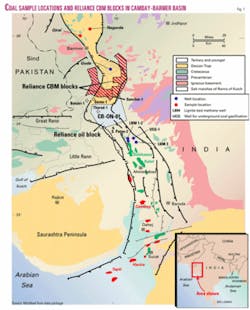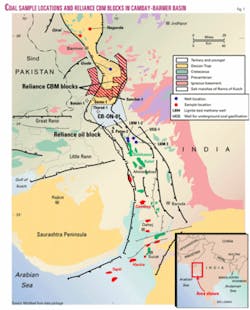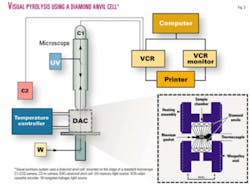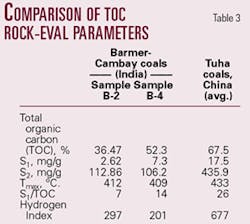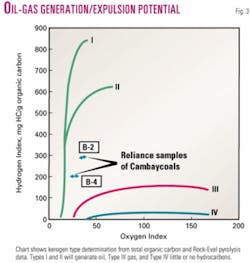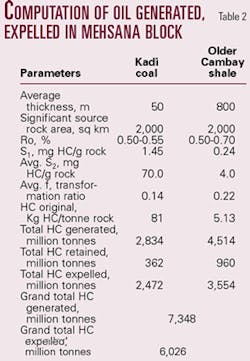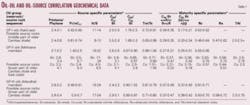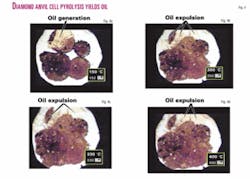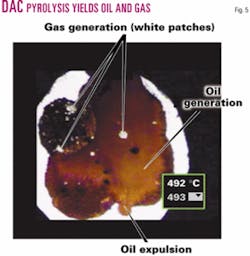Some fields in India's North Cambay basin have oil derived from nearby lignite seams
Questioning coal as a possible oil source can no longer be taken seriously.
It is well known that coal generates natural gas called coalbed methane, or CBM. In the US, coalbed methane is produced in many coal basins and contributes a growing share of the country's natural gas production.
Strangely, pyrolysis experiments on organic matter have all failed to reproduce the composition of natural gas, typically 91% methane. But natural gas can be generated in the laboratory catalytically by transition-metals often found in sedimentary rocks.
Snowdon1 questioned this catalysis theory. He argued with the help of data from drill cuttings that gas generated in shales and coals resembles natural gas, but in the process of migrating and becoming trapped in a reservoir formation the gas composition is altered to contain some light hydrocarbons.
A more controversial subject is about coal as a source of oil. Although several investigators have put forth evidence and analyses that depict coals as the most likely oil source, by and large, they are not based on clinching evidence but rather on circumstantial and indirect evidence.
For instance, Wilkins et al.2 wrote that:
"Unambiguous evidence of expulsion (of oil) from coals is limited, and in particular only a few commercial discoveries can be confidently correlated to coals. They include Upper Cretaceous Fruitland formation coals in the US, from which oil is produced, New Zealand Tertiary coals, and Middle Jurassic coals from the Danish [North] Sea.
"It is likely that coals have at least contributed to significant oil discoveries in the Gippsland basin, Australia, in the Turpan basin, China, and in the Kutei and Ardjuna basins in Indonesia, but this remains unproven.
"None of the 'rules of thumb' for generation or expulsion of petroleum from coals seems particularly robust. Decision on whether a particular coal is likely to have been an active source for oil should consider all available geological and geochemical information," wrote Wilkins et al.
Questioning convention
Conventional wisdom is that oil generated from dispersed organic matter in shales will be expelled, but oil generated from humic coals might not be expelled from coal because of the microporous structure of coal. This view can be questioned.
Transformation of exinite macerals in coal will create macroporosity, resulting in an 'open system.' This will in fact facilitate expulsion of oil from coal. And microfractures and faults conducive to migration of oil can be expected to be present.
According to Shanmugam,3 "the expulsion of liquid hydrocarbons only occurs after the kerogen (or coal) has reached a saturation point." The key to coal as source for oil fields is expulsion rather than generation.
The author of this article studied the lignito-bituminous coals of Eocene age that occur over a vast area in the northern part of the Cambay oil province/Barmer oil province in western India (Fig. 1) and concluded that these lignites have generated and expelled large volumes of oil in these basins. In fact, the crude oils in some of the oil fields are reported to be a mixture of shale-derived and coal-derived petroleum.4
To test this conclusion, we have resorted to the visualization of oil generation/expulsion by means of a video-capturing of pyrolysis of the lignite samples by the new technique using a diamond anvil cell (DAC).
W.L. Huang developed this technique about a decade ago when in Exxon Production Research Co., Houston.5 He performed DAC pyrolysis experiments on Reliance's lignite samples in June 2004 in National Taiwan University as a professor in the Department of Geosciences.
Additionally, we will show a comparison of the source-related coal data of Cambay-Barmer lignites with the data of China's Tuha coal basin contained in a paper by Liu Dehan et al.6 in the Chinese Science Bulletin in mid-2000. This paper was selected for benchmarking because its approach is by reference to certain evaluation indices for coal as an oil source and because the points of evidence are direct and unambiguous.
Neglect of coal as a probable source rock for oil sometimes leads to misidentification of source rocks in a petroleum system. Conventional thinking is that humic coals are largely gas-prone.
The traditional practice to distinguish between oil-prone and gas-prone coals and other source rocks is to compare the values of Hydrogen Index or the Van Krevelen diagram, the microscope study of macerals or organic matter, and correlate the results with organic geochemical parameters, as for example with the Lulita oil field in Danish North Sea.
In recent years, pyrolysis-gas chromatography (py-gc) has been used to identify oil-prone coals. It showed consistent relationship between HI and long chain-aliphatic groups. Huang5 developed a method based on the diamond anvil cell (DAC) pyrolysis technique to characterize and distinguish oil-prone coals from gas-prone coals (Fig. 2).
Real-time video recording of experiments is obtained with a high-resolution charge coupled device (CCD) for video camera and time-lapse videocassette recording.
A second black-and-white CCD video camera allows a display of the DAC temperatures to be superimposed in one corner of the image of the diamond cell's reaction chamber. This enables simultaneous display and recording of the reaction and the associated temperature profile.
Hard copies of color pictures are printed from VCR tape using a Sony video color printer (Model 3000). Images recorded on a VCR can be captured with a 24-bit color frame grabber mounted in a PC.
DAC pyrolysis
Before discussing the DAC pyrolysis data obtained by the courtesy of Prof. Huang on our lignite samples, we give a brief background of the lignito-bituminous coals in the Cambay-Barmer basins.
More information is available in a previous OGJ article, including a map of the two coal basins north of 23° N. Lat. and the lignite sample location at the Giral open-cast mine near Barmer and the Nagurda core holes near Barmer city at about 26° N. Lat.7
The lignites occur at depths ranging 700 m to 1,600 m and in two major seams of 5-45 m and 10-60 m thick. Broadly, these lignitic coals have 72-76% carbon content, somewhat higher hydrogen content (5.4%) compared with other lignitic deposits, and 0.2% sulfur content. Vitrinite reflectance ranges from 0.30 to 0.40%. But the seams have about 20% exinite (liptinite) and 79% vitrinite (huminite) on a mineral matter-free basis.
Besides macerals and sedimentary environment, types and degrees of coalification are important factors on hydrocarbon potential of coal. Also, S1, S2, HI, TOC in Rock-Eval analysis, and HC, R% are economic and practical indices of oil and gas potential in coals. Of these, S1 is considered to be more important.
Table 3 gives a comparison of these values between the Tuha basin and Cambay-Barmer basin coal samples.
Although S1 + S2 in the Barmer/Cambay sample is 113.5 mg/g and less than the 120 mg/g needed to call it 'good' potential for oil, the more important S1 value is 7.3 mg/g showing it to be a 'good' potential. And the HI value is within the range for a 'good' source for oil. Moreover, the exinite content of coal is about 20%, well within the 10-30% range for a 'good' oil generating coal as per Chinese evaluation criteria. The sample B-2 has better properties than sample B-4 in all these parameters.
Note that the Barmer sample is at a shallow depth in the northern flank of the coal basin. Deeper coals have higher hydrogen content and higher exinite content in maceral composition.
Hence, these coals should probably have values more comparable with the Tuha samples. However, we may say conservatively that the Barmer-Mehsana (Cambay) coals can be classified as intermediate between Type II and Type III and may have potential for both oil and gas generation/expulsion (Fig. 3).
Cambay-Barmer potential
Now let us examine the generating and expulsion potential of the Cambay-Barmer coals. Raza Khan et al.4 assessed the amount of generated and expelled hydrocarbons in the Mehsana Block of the Cambay basin for the coals and enclosing shales separately (Table 2).
Raza Khan et al. also prepared a table showing oil-oil and oil-source (coal, shale) correlation geochemical data (Table 1). Those authors considered that, of the three groups of oil examined, Group II (Mehsana) oils have relatively high concentrations of C30 sterane, but the Pr/nC17 value is >1.0. It distinctly differentiates this group from the other two and points to coal as the oil source.
In fact, the oil in the Mehsana Block is a mixture of oil derived from coals and the enclosing Cambay shales, according to Anand Pande et al.,8 who studied the organic geochemical perspective of the origin of oil in the block.
The author of this article estimates the CBM in place on the 2,000 sq km Mehsana Block considered for study by Raza Khan4 et al. to be about 150 bcm, taking an average 5 cm/ton of adsorbed gas content in the coals. This would be equivalent to 900 million bbl (about 130 million tonnes) of oil.
Ten times this volume of CBM might have been expelled from coals by diffusion and other migration mechanisms. Therefore, using Raza Khan et al.'s Table 2, 1,472 million tonnes of oil might have escaped from coal, a small part of which (say 10% or 150 million tonnes) would have been trapped in reservoir-type facies around and upward.
Oil remaining within coal at places is likely to be as much as CBM in place in oil-equivalent basis, using the value of 362 million tonnes of hydrocarbons retained as estimated by Raza Khan et al. Also in a well drilled in the basin margin, the coal cores showed abundant globules of oil and oil shows in the silt/chert intercalations between coal and seams.
The above calculation relates to about one third of the lignito-bituminous coal basin in the Cambay-Barmer area that includes the Mehsana Block as its southern part. Therefore it is probable that the aggregate volume of coal-sourced oil deposits in sands and noncoal reservoirs in the entire area will be larger but well within reasonable expectations.
Thus the coal-sourced oil accumulations in the basin can be conjectured to be in a wide range of 1 billion to 2 billion bbl. To date, however, no oil field that contains only coal-sourced oil has been discovered, but oil fields in the Mehsana Block are said to have a mixed-type crude with some contribution from coals.4
Fig. 4 shows still photos from a video clip of the oil generation and expulsion at different temperatures of pyrolysis in the lignitic coal sample from a very shallow core hole in Barmer (Fig. 3).
CBM might have been generated from the oil at much higher temperatures of 550° C. or more (Fig. 5); seeing is believing. Such visual evidence is more convincing than the standard pyrolysis experiments and analysis. It may be noted that retained bitumen content in these coals is very small, as per studies by Yadav and Vig.9
Almond coals
It may be of interest to compare the oil generation in coal beds in Wyoming.
Most of the oil and gas in the Green River, Washakie, and Great Divide basins occur in Cretaceous sandstone reservoirs of the Dakota, Frontier, and Almond formations. Their source is the coal beds in the Almond formation, as confirmed in a study reported in the AAPG Bulletin.
The authors proved not only proved that coals in the Almond formation generate oil and gas but also showed how this takes place and how the newly-formed oil gets squeezed out of the coal so that it is free to migrate. The formation of porosity in coal is a direct result of oil generation, the later closing up of the pores and vesicles follows the expulsion of oil from coal matrix into microfracture.
Increasing interval pressure with oil generation causes coals to fracture, creating connections between pores and vesicles. Such a picture can be visualized from the generation/expulsion in coals as in Fig. 4.
The maximum generation capacity of Almond coals is 27 mg of oil/gram of coal and of CBM it is 839 cf/metric ton of coal. In comparison, the Cambay-Barmer lignito-bituminous coals are estimated to generate not more than 1 mg oil/gram of coal and 180 cf of CBM/ton of coal. Even then, it seems that one can look forward to sizable coal-sourced oil deposits in the Cambay-Mehsana-Barmer area.
Exploration value
The concepts of hydrocarbon generation, expulsion, and migration are important parts of petroleum exploration besides the traditional methods in search of structural and stratigraphic traps. This rule applies as much to noncoal basins as to coal basins.
It is hoped this point of view will be appreciated from this study of lignito-bituminous coals of western India and the results obtained by other investigations in several basins where oil is shown to be derived from coals.
Published geochemical studies made by ONGC on the coals in the north Cambay/Barmer basin (for instance Pande, A., et al.)8 have concluded that oils produced in the formation containing these coals such as those in Sobhasan and Lynch oil fields in North Gujarat have received a certain contribution from the oil generated in these coals.
Besides, only a very small part of bitumen has been retained in these coals in experiments made by Yadav, T., et al.9 It is significant that conversion of liquid hydrocarbons to CBM is not evident in the video monitoring of DAC pyrolysis experiments up to 550° C. Therefore, the balance of evidence seems to be in favor of considering the early oil formation below 300° C. in the B-2 sample to be a case of true hydrocarbon generation at low thermal stress.
Such occurrences have been mentioned in the cases of Gippsland offshore coals in Australia, Tertiary coals in the Assam basin, Northeast India, and in Mahakam coals in Indonesia. Thus, the copious generation and expulsion of oil from the B-2 sample shown in Figs. 4 and 5 at temperatures below 300° C. may be interpreted as true oil generation.
References
1. Snowdon, L.R., "Natural gas composition in a geological environment and the implications for the process of generation and preservation," Organic Geochemistry, Vol. 32, 2001, pp. 913-931.
2. Wilkins, R.W.T., and George, S.C., "Coal as a source rock for oil: a review," International Journal of Coal Geology, Vol. 50, 2002, pp. 317-361.
3. Shanmugam, G., "Significance of coniferous rain forests and related organic matter in generating commercial quantities of oil, Gippsland Basin, Australia," AAPG Bull., Vol. 69, 1985, pp. 1,241-54.
4. Raza Khan, M.S., Srivastava, M.C., and Sharma, S.K., "Genesis and Entrapment of Hydrocarbons in Mehsana Block, North Gujarat, India," Proceedings of Petrotech-2003, New Delhi.
5. Huang, W.L., "A new pyrolysis technique using diamond anvil cell: in situ visualization of kerogen transformation," Organic Geochemistry, Vol. 24, 1996, pp. 95-107.
6. Liu Dehan, Zhang Huizhi, Dai Jinxing, Sheng Guoying, Xiao Xianming, Son Yongge, and Seng Jiagui, "Experimental study and evaluation on hydrocarbon generation of macerals," Chinese Science Bull., Vol. 45, No. 14, 2000, pp. 1,270-75.
7. Ramaswamy, G., "A field evidence for mineral catalyzed formation of gas during coal maturation," OGJ, Sept. 16, 2002, pp. 32-36.
8. Pande, A., Singh, B.P., Raza Khan, M.S., and Misra, K.S., "Organic Geochemical Perspective of the Origin of Oil: A Case Study of Kadi Formation Oils, North Cambay Basin, India," Proceedings of Petrotech-2, New Delhi, 1997, pp. 223-235.
9. Yadav, T., and Vig, K.C., "Retention Behaviour of Bitumen in coals and shales of Indian sedimentary basins," Petrotech-95, New Delhi, pp. 235-244.
The author
Gopal Ramaswamy (Gopal_Ramaswamy@ ril.com) is an advisor to Reliance Industries Ltd. and former managing director of Reliance Gas (Pty.) Ltd. He worked as a geophysicist for ExxonMobil Corp.'s Stanvac unit in India in 1952-62 and later as a consultant to Petrobras in 1963-64. He served as an exploration advisor for the Indian Ministry of Petroleum & Chemicals in 1970-80 and was in charge of exploration and development of the Bombay High oil and gas fields. In the early 1990s he was senior author of the first CBM studies in India that led to the drilling of three promising wells in the Cambay basin and other wells in the eastern coal fields. He holds a PhD in physics.
